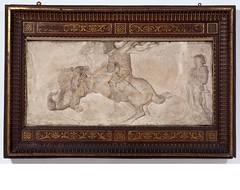By Stuart Frost
 This year St George’s day falls on Monday 23 April. There are a large number of images of St George in the V&A’s collections. Most of them are not English. It may come as a surprise to many English people to discover that St George is a figure with a Middle Eastern background who was popular throughout Europe and even further afield. The image reproduced here features a cast taken from a sculpture made by Donatello. The sculpture was installed on the exterior of the church of Orsanmichele in Florence. Click on the image for a better view and more information about the object.
This year St George’s day falls on Monday 23 April. There are a large number of images of St George in the V&A’s collections. Most of them are not English. It may come as a surprise to many English people to discover that St George is a figure with a Middle Eastern background who was popular throughout Europe and even further afield. The image reproduced here features a cast taken from a sculpture made by Donatello. The sculpture was installed on the exterior of the church of Orsanmichele in Florence. Click on the image for a better view and more information about the object.
St George’s cult has a long history. Churches were dedicated to him in Jerusalem and Antioch as early as the sixth century. His story is told in the The Golden Legend, an extremely popular late medieval book. Most memorably George defeated a dragon that was terrorising the local population, and rescued the king’s daughter from its jaws. In return the king’s subjects converted to Christianity. George was believed to have been put death in around 303, the result of the persecution of Christians by the Roman emperor. By the late middle ages George had become an extremely popular figure in England, but also in some Italian states, Portugal and Catalonia. The detail below is part of a painted altarpiece from Spain.
 St George has been an important figure for Christians in Ethiopia for a very long period of time. The cathedral in Addis Ababa, built in 1898 by the Emperor Menelik, is dedicated to the saint. Considerably older is the magnificent rock-hewn church of Bet Giyorgis (Place of George) at Lalibela. The churches at Lalibela are thought to date to the 12th or 13th centuries. The church dedicated to George is the arguably the most impressive. Its plan follows that of a square cross and the church is carved entirely out of solid rock. St George is represented frequently in Ethiopian art, often following earlier Italian or Byzantine models that were introduced into the country and adapted subsequently.
St George has been an important figure for Christians in Ethiopia for a very long period of time. The cathedral in Addis Ababa, built in 1898 by the Emperor Menelik, is dedicated to the saint. Considerably older is the magnificent rock-hewn church of Bet Giyorgis (Place of George) at Lalibela. The churches at Lalibela are thought to date to the 12th or 13th centuries. The church dedicated to George is the arguably the most impressive. Its plan follows that of a square cross and the church is carved entirely out of solid rock. St George is represented frequently in Ethiopian art, often following earlier Italian or Byzantine models that were introduced into the country and adapted subsequently.
George has recently been seen by some as a controversial figure for English society today. The press carried stories last year about a campaign for St George to be replaced by St Alban as England’s patron saint. It is inevitable that opinions about the role of the saint as a focus for national identity will vary. Some sections of the press have argued that the English fail to celebrate St George’s day enough. Comparisons with St Patrick’s Day in Ireland are made each year. I have been sent a St Patrick’s Day card before, but not one for St George’s Day, even though they are now available.
That debates still resurface regularly in the media are evidence that the legacy of our medieval past still has relevance today. St George has been a popular figure for religious devotion, and national identity, for a considerable period of time. England may have one of the fastest secularising societies in Europe but St George still remains a culturally significant figure. In other parts of the world, like Ethiopia for example, St George also retains a strong relevance to daily life and religious practice. To find more images of Saint George search in the V&A’s collections visit Collections Online.